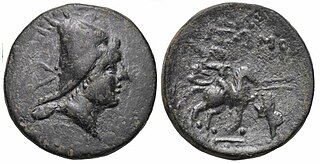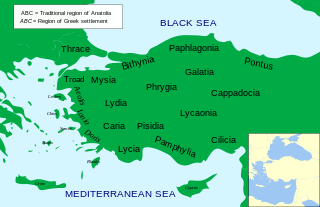Related Research Articles
This article concerns the period 69 BC – 60 BC.
Antiochus is a Greek male first name, which was a dynastic name for rulers of the Seleucid Empire and the kingdom of Commagene. In Jewish historical memory, connected with the Maccabean Revolt and the holiday of Hanukkah, "Antiochus" refers specifically to Antiochus IV Epiphanes.
Mithridates or Mithradates is the Hellenistic form of an Iranian theophoric name, meaning "given by Mithra". Its Modern Persian form is Mehrdad. It may refer to:

Gaius Julius Antiochus IV Epiphanes, the last king of Commagene, reigned between 38 and 72 as a client king to the Roman Empire. The epithet "Epiphanes" means "the Glorious".

Antiochus I Theos Dikaios Epiphanes Philorhomaios Philhellen was king of the Greco-Iranian kingdom of Commagene and the most famous king of that kingdom.
Iotapa may refer to:
Epiphanes, meaning "God Manifest" or "the Glorious/Illustrious", is an ancient Greek epithet borne by several Hellenistic rulers:
The Orontid dynasty, also known as the Eruandids or Eruandunis, ruled the Satrapy of Armenia until 330 BC and the Kingdom of Armenia from 321 BC to 200 BC. The Orontids ruled first as client kings or satraps of the Achaemenid Empire and after the collapse of the Achaemenid Empire established an independent kingdom. Later, a branch of the Orontids ruled as kings of Sophene and Commagene. They are the first of the three royal dynasties that successively ruled the antiquity-era Kingdom of Armenia.

Arsames I seems to have taken control of Commagene, Sophene and Armenia in the year 260 BC after the death of his grandfather Orontes III, king of Armenia, and his father Sames, king of Commagene.

Commagene was an ancient Greco-Iranian kingdom ruled by a Hellenized branch of the Iranian Orontid dynasty that had ruled over Armenia. The kingdom was located in and around the ancient city of Samosata, which served as its capital. The Iron Age name of Samosata, Kummuh, probably gives its name to Commagene.
Ptolemaeus was initially the satrap of Commagene, later becoming its first king in 163 BC. He belonged to the Orontid dynasty, founded by Orontes I. Ptolemaeus' father was King Orontes IV of Armenia, son of Arsames I.
Antiochus III Epiphanes was the ruler of the Kingdom of Commagene from 12 BC to 17 AD. He was the son and successor of King Mithridates III of Commagene and Iotapa, and of mixed Iranian, Armenian, Greek and Median descent – the last through his mother. His parents were first cousins.
Gaius Julius Alexander II was a Herodian Prince who lived in the 1st century and 2nd century in the Roman Empire.
Gaius Julius Archelaus Antiochus Epiphanes, also known as Julius Archelaus Epiphanes; Epiphanes; Gaius Julius Antiochus Epiphanes or simply known as Gaius was an influential prince of the Kingdom of Commagene, who lived in the 1st century.
Callinicus was a prince of the Kingdom of Commagene, who lived in the 1st century AD. Callinicus was the second-born son and child to King Antiochus IV of Commagene and Queen Iotapa of Commagene. His parents were full-blooded siblings. His parents were Roman Client Monarchs of Commagene that lived under the Roman Empire in the 1st century. His older brother was prince Gaius Julius Archelaus Antiochus Epiphanes and youngest sibling was princess Iotapa.

Classical Anatolia is Anatolia during classical antiquity. Early in that period, Anatolia was divided into several Iron Age kingdoms, most notably Lydia in the west, Phrygia in the center and Urartu in the east. Anatolia fell under Achaemenid Persian rule c. 550 BC. In the aftermath of the Greco-Persian Wars, all of Anatolia remained under Persian control except for the Aegean coast, which was incorporated in the Delian League in the 470s BC. Alexander the Great finally wrested control of the whole region from Persia in the 330s BC. After Alexander's death, his conquests were split amongst several of his trusted generals, but were under constant threat of invasion from both the Gauls and other powerful rulers in Pergamon, Pontus, and Egypt.
Julia Iotapa or Julia Iotape, daughter of King Antiochus IV of Commagene, was a Queen of Cetis, consort of Gaius Julius Alexander, son of Herodian prince Gaius Julius Tigranes.
References
- ↑ Shayegan 2016, pp. 8, 13.